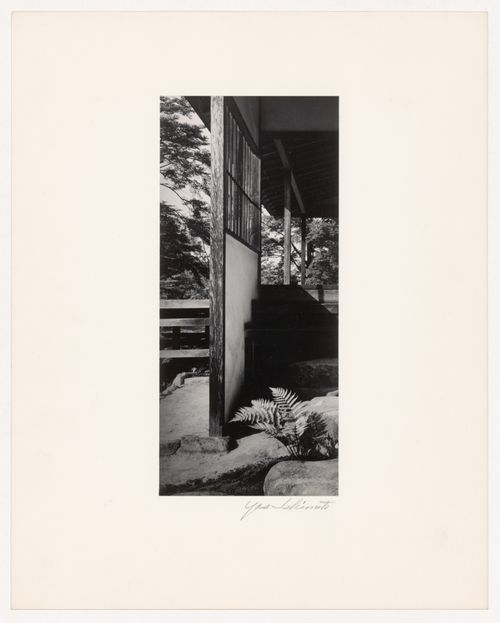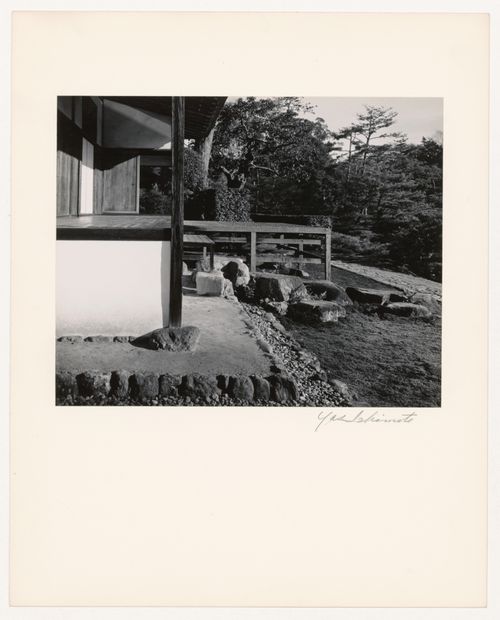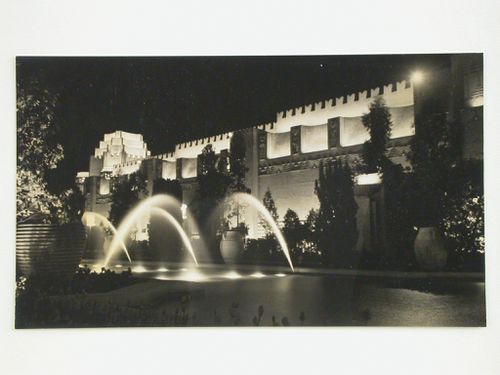PH1986:0176
Description:
- Photographs PH1986:0148 - PH1986:0283 form a sequence of views. Accession numbers follow an order established by the photographer that is based on the temporal experience of walking through the grounds of Katsura Rikyu (also known as Katsura Imperial Villa) (see acquisition file). - Yasuhiro Ishimoto returned to Katsura Rikyu (also known as Katsura Imperial Villa) in 1982 and took another series of photographs, this time with many in colour, often using the same or very similar views to those of his 1953 photographs at the same location (Ishimoto, p. 266).
architecture
1953
View of a grille wall and the stairs to the Moon-viewing Platform and the broad veranda of the Old Shoin, Katsura Rikyu (also known as Katsura Imperial Villa), Kyoto, Japan
Actions:
PH1986:0176
Description:
- Photographs PH1986:0148 - PH1986:0283 form a sequence of views. Accession numbers follow an order established by the photographer that is based on the temporal experience of walking through the grounds of Katsura Rikyu (also known as Katsura Imperial Villa) (see acquisition file). - Yasuhiro Ishimoto returned to Katsura Rikyu (also known as Katsura Imperial Villa) in 1982 and took another series of photographs, this time with many in colour, often using the same or very similar views to those of his 1953 photographs at the same location (Ishimoto, p. 266).
architecture
PH1986:0177
Description:
- Photographs PH1986:0148 - PH1986:0283 form a sequence of views. Accession numbers follow an order established by the photographer that is based on the temporal experience of walking through the grounds of Katsura Rikyu (also known as Katsura Imperial Villa) (see acquisition file). - Yasuhiro Ishimoto returned to Katsura Rikyu (also known as Katsura Imperial Villa) in 1982 and took another series of photographs, this time with many in colour, often using the same or very similar views to those of his 1953 photographs at the same location (Ishimoto, p. 266).
architecture, landscape architecture
1953
View of the broad veranda and the Moon-viewing Platform showing the eaves gutter and the southeast entrance of the Old Shoin, Katsura Rikyu (also known as Katsura Imperial Villa), Kyoto, Japan
Actions:
PH1986:0177
Description:
- Photographs PH1986:0148 - PH1986:0283 form a sequence of views. Accession numbers follow an order established by the photographer that is based on the temporal experience of walking through the grounds of Katsura Rikyu (also known as Katsura Imperial Villa) (see acquisition file). - Yasuhiro Ishimoto returned to Katsura Rikyu (also known as Katsura Imperial Villa) in 1982 and took another series of photographs, this time with many in colour, often using the same or very similar views to those of his 1953 photographs at the same location (Ishimoto, p. 266).
architecture, landscape architecture
PH1981:1009:009
architecture
between 1939 and 29 September 1940
architecture
PH1986:0197
Description:
- Photographs PH1986:0148 - PH1986:0283 form a sequence of views. Accession numbers follow an order established by the photographer that is based on the temporal experience of walking through the grounds of Katsura Rikyu (also known as Katsura Imperial Villa) (see acquisition file). - Yasuhiro Ishimoto returned to Katsura Rikyu (also known as Katsura Imperial Villa) in 1982 and took another series of photographs, this time with many in colour, often using the same or very similar views to those of his 1953 photographs at the same location (Ishimoto, p. 266).
architecture, landscape architecture
1953
View of the Moon-viewing Platform and the broad veranda of the Old Shoin showing the moss garden and the south lawn (also known as the court football [kemari] field) in the background, Katsura Rikyu (also known as Katsura Imperial Villa), Kyoto, Japan
Actions:
PH1986:0197
Description:
- Photographs PH1986:0148 - PH1986:0283 form a sequence of views. Accession numbers follow an order established by the photographer that is based on the temporal experience of walking through the grounds of Katsura Rikyu (also known as Katsura Imperial Villa) (see acquisition file). - Yasuhiro Ishimoto returned to Katsura Rikyu (also known as Katsura Imperial Villa) in 1982 and took another series of photographs, this time with many in colour, often using the same or very similar views to those of his 1953 photographs at the same location (Ishimoto, p. 266).
architecture, landscape architecture
ARCH400121
Description:
Notes and sketches explaining the new, expanded scope for architecture after the moon landing.
ca. 1970-1971
Notes and sketches for Architettura Interplanetaria [Interplanetary Architecture]
Actions:
ARCH400121
Description:
Notes and sketches explaining the new, expanded scope for architecture after the moon landing.
Project
AP148.S1.1970.PR02
Description:
The project series documents Poli's work on the Interplanetary Architecture project, which was also made into a film by Superstudio directed by Alessandro Poli (the film is not included in the fonds). The project reflects Poli's deep fascination with the moon landing in 1969. Poli uses this major media event as a catalyst for thinking about a new approach to architecture and tools for design, including the idea that film and the movie camera should become part of the toolset. The project also seems to be in some way a response to Epoch magazine's challenge for a "Primo concorso di architettura nello spazio" (the first architectural competition in space), and includes much imagery and textual references to a new road or architectural links between the earth and other planets, including an earth moon highway. In his storyboard, Poli also makes reference to his earlier Piper project, and some imagery features wheels and an amusement park. The Interplanetary Architecture project was exhibited by Superstudio in Rome in 1972 and featured in "Casabella" magazine in April 1972 (no. 364). The project was also featured in the 2010 CCA exhibition "Other Space Odysseys". In the accompanying CCA publication, Poli describes this project as "a voyage off earthbound routes in quest of architecture unfettered by the urban nightmare, by induced needs or by planning as the only tool for regulating and solving the world's problems" (Poli quoted in Borasi and Zardini, 2010, 110). Poli's work on this project is deeply tied to the Zeno project, which was also featured in this exhibition and is included in this fonds (see AP148.S1.1972.PR01). For the Zeno project, Poli envisioned a dialogue between astronaut Buzz Aldrin and an Italian peasant, Zeno of Riparbella. Poli felt that these two shared a similarity in that both their homes were isolated capsules, one that provided a lens from which to see the rest of the world and understand their place in it. The material in the series includes numerous photomontages and collages of astronauts in space, as well as drawings of plantery shapes and structures. There are also texts, some of which include calculations of distances and diameters of planets, as well as notebooks and sketchbooks, many of which Poli included in a folder he entitled "Storyboard." The series also includes an unsent letter from Poli to Adolfo Natalini which describes how, after the moon landing, everything - the planet, the moon, the stars - is architecture, and that this will necessitate the need for new design tools, such as the movie camera. Some works are signed Alessandro Poli-Superstudio. Source cited: Giovanna Borasi and Mirko Zardini, eds., Other Space Odysseys, Montreal and Baden: Canadian Centre for Architecture/Lars Müller Publishers, 2010.
1969-1971
Architettura Interplanetaria [Interplanetary Architecture] (1970-1971)
Actions:
AP148.S1.1970.PR02
Description:
The project series documents Poli's work on the Interplanetary Architecture project, which was also made into a film by Superstudio directed by Alessandro Poli (the film is not included in the fonds). The project reflects Poli's deep fascination with the moon landing in 1969. Poli uses this major media event as a catalyst for thinking about a new approach to architecture and tools for design, including the idea that film and the movie camera should become part of the toolset. The project also seems to be in some way a response to Epoch magazine's challenge for a "Primo concorso di architettura nello spazio" (the first architectural competition in space), and includes much imagery and textual references to a new road or architectural links between the earth and other planets, including an earth moon highway. In his storyboard, Poli also makes reference to his earlier Piper project, and some imagery features wheels and an amusement park. The Interplanetary Architecture project was exhibited by Superstudio in Rome in 1972 and featured in "Casabella" magazine in April 1972 (no. 364). The project was also featured in the 2010 CCA exhibition "Other Space Odysseys". In the accompanying CCA publication, Poli describes this project as "a voyage off earthbound routes in quest of architecture unfettered by the urban nightmare, by induced needs or by planning as the only tool for regulating and solving the world's problems" (Poli quoted in Borasi and Zardini, 2010, 110). Poli's work on this project is deeply tied to the Zeno project, which was also featured in this exhibition and is included in this fonds (see AP148.S1.1972.PR01). For the Zeno project, Poli envisioned a dialogue between astronaut Buzz Aldrin and an Italian peasant, Zeno of Riparbella. Poli felt that these two shared a similarity in that both their homes were isolated capsules, one that provided a lens from which to see the rest of the world and understand their place in it. The material in the series includes numerous photomontages and collages of astronauts in space, as well as drawings of plantery shapes and structures. There are also texts, some of which include calculations of distances and diameters of planets, as well as notebooks and sketchbooks, many of which Poli included in a folder he entitled "Storyboard." The series also includes an unsent letter from Poli to Adolfo Natalini which describes how, after the moon landing, everything - the planet, the moon, the stars - is architecture, and that this will necessitate the need for new design tools, such as the movie camera. Some works are signed Alessandro Poli-Superstudio. Source cited: Giovanna Borasi and Mirko Zardini, eds., Other Space Odysseys, Montreal and Baden: Canadian Centre for Architecture/Lars Müller Publishers, 2010.
Project
1969-1971
The CCA hosts a second afternoon of discussion on the work of Cedric Price, with the participation of Samantha Hardingham, Whitney Moon, Molly Wright Steenson, Kathy Velikov, and Mark Wigley. As Price’s archive is one of the most consulted at the CCA, we have invited scholars, mostly from North America, to present their individual motivations and methodologies for(...)
9 February 2017
An Afternoon with Cedric Price no. 2
Actions:
Description:
The CCA hosts a second afternoon of discussion on the work of Cedric Price, with the participation of Samantha Hardingham, Whitney Moon, Molly Wright Steenson, Kathy Velikov, and Mark Wigley. As Price’s archive is one of the most consulted at the CCA, we have invited scholars, mostly from North America, to present their individual motivations and methodologies for(...)
drawings
Quantity:
2 presentation drawing(s)
DR2004:1406
Description:
Note attached to drawings, possibly written by CCA staff, reads: 'City of the Future / - sheets go together / - not part of Cooper Hewitt / - exhibited in Cities on the Moon / shown in Hong Kong, Moscow'.
Panoramic perspective sketch in 2 parts
Actions:
DR2004:1406
Description:
Note attached to drawings, possibly written by CCA staff, reads: 'City of the Future / - sheets go together / - not part of Cooper Hewitt / - exhibited in Cities on the Moon / shown in Hong Kong, Moscow'.
drawings
Quantity:
2 presentation drawing(s)
research
TD Bank Group-CCA Collection Research Grant Recipients: Negin Djavaherian (McGill University); Izabel Amaral (Université de Montréal); Geoffrey Carr (University of British Columbia); Jason Crow (McGill University); Claudette Lauzon (McGill University); Elena Napolitano (University of Toronto); Victoria Sheridan (University of Toronto); Gyewon Kim (McGill(...)
April 2008 to September 2008
Doctoral Students Program 2008
Actions:
Description:
TD Bank Group-CCA Collection Research Grant Recipients: Negin Djavaherian (McGill University); Izabel Amaral (Université de Montréal); Geoffrey Carr (University of British Columbia); Jason Crow (McGill University); Claudette Lauzon (McGill University); Elena Napolitano (University of Toronto); Victoria Sheridan (University of Toronto); Gyewon Kim (McGill(...)
research
April 2008 to
September 2008
research
Visiting Scholars 2018
Elisa Dainese,Dalhousie University, Canada Architectural Culture in Translation: Postwar Cities and African Villages Martina Hrabová, Institute of Art History, Czech Academy of Sciences, Czech Republic The Geography of an Intellectual Field: The Social Network of Le Corbusier’s Studio Lina Malfona, Rome Sapienza, Italy Political Mind: Alvaro Siza’s Urban Projects From(...)
June 2018 to September 2018
Visiting Scholars 2018
Actions:
Description:
Elisa Dainese,Dalhousie University, Canada Architectural Culture in Translation: Postwar Cities and African Villages Martina Hrabová, Institute of Art History, Czech Academy of Sciences, Czech Republic The Geography of an Intellectual Field: The Social Network of Le Corbusier’s Studio Lina Malfona, Rome Sapienza, Italy Political Mind: Alvaro Siza’s Urban Projects From(...)
research
June 2018 to
September 2018



![View of the Moon-viewing Platform and the broad veranda of the Old Shoin showing the moss garden and the south lawn (also known as the court football [kemari] field) in the background, Katsura Rikyu (also known as Katsura Imperial Villa), Kyoto, Japan](/img-collection/1CBsJAkDJb4BS29g0DEFbZMu508=/500x637/362732.jpg)
![Notes and sketches for Architettura Interplanetaria [Interplanetary Architecture]](/img-collection/mp3J8iER7bf4lyNmx3gBm_hYEFg=/500x707/485407.jpg)
